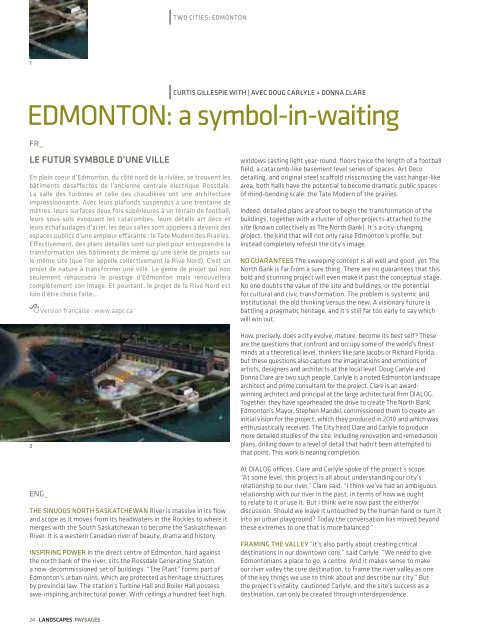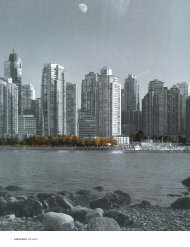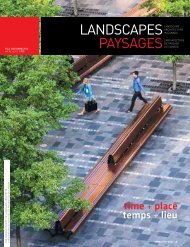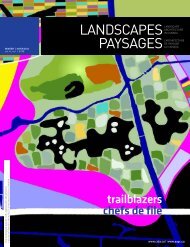Spring | Printemps 2011 - CSLA :: AAPC
Spring | Printemps 2011 - CSLA :: AAPC
Spring | Printemps 2011 - CSLA :: AAPC
You also want an ePaper? Increase the reach of your titles
YUMPU automatically turns print PDFs into web optimized ePapers that Google loves.
TWO CITIES: EDMONTON<br />
1<br />
CURTIS GILLESPIE WITH | AVEC DOUG CARLYLE + DONNA CLARE<br />
EDMONTON: a symbol-in-waiting<br />
FR_<br />
LE FUTUR SYMBOLE D’UNE VILLE<br />
En plein coeur d’Edmonton, du côté nord de la rivière, se trouvent les<br />
bâtiments désaffectés de l’ancienne centrale électrique Rossdale.<br />
La salle des turbines et celle des chaudières ont une architecture<br />
impressionnante. Avec leurs plafonds suspendus à une trentaine de<br />
mètres, leurs surfaces deux fois supérieures à un terrain de football,<br />
leurs sous-sols évoquant les catacombes, leurs détails art déco et<br />
leurs échafaudages d’acier, les deux salles sont appelées à devenir des<br />
espaces publics d’une ampleur effarante : le Tate Modern des Prairies.<br />
Effectivement, des plans détaillés sont sur pied pour entreprendre la<br />
transformation des bâtiments de même qu’une série de projets sur<br />
le même site (que l’on appelle collectivement la Rive Nord). C’est un<br />
projet de nature à transformer une ville. Le genre de projet qui non<br />
seulement rehaussera le prestige d’Edmonton mais renouvellera<br />
complètement son image. Et pourtant, le projet de la Rive Nord est<br />
loin d’être chose faite...<br />
2<br />
ENG_<br />
V ersion française : www.aapc. ca<br />
THE SINUOUS NORTH SASKATCHEWAN River is massive in its flow<br />
and scope as it moves from its headwaters in the Rockies to where it<br />
merges with the South Saskatchewan to become the Saskatchewan<br />
River. It is a western Canadian river of beauty, drama and history.<br />
INSPIRING POWER In the direct centre of Edmonton, hard against<br />
the north bank of the river, sits the Rossdale Generating Station,<br />
a now-decommissioned set of buildings. “The Plant” forms part of<br />
Edmonton’s urban ruins, which are protected as heritage structures<br />
by provincial law. The station’s Turbine Hall and Boiler Hall possess<br />
awe-inspiring architectural power. With ceilings a hundred feet high,<br />
windows casting light year-round, floors twice the length o f a football<br />
field, a catacomb-like basement level series of spaces, Art Deco<br />
detailing, and original steel scaffold crisscrossing the vast hangar-like<br />
area, both halls have the potential to become dramatic public spaces<br />
of mind-bending scale: the Tate Modern of the prairies.<br />
I ndeed, detailed plans are afoot to begin the transformation of the<br />
buildings, together with a cluster of other projects attached to the<br />
site (known collectively as The North Bank). It’s a city-changing<br />
project, the kind that will not only raise Edmonton’s profile, but<br />
instead completely refresh the city’s image.<br />
NO GUARANTEE S The sweeping concept is all well and good, yet The<br />
North Bank is far from a sure thing. There are no guarantees that this<br />
bold and stunning project will even make it past the conceptual stage.<br />
No one doubts the value of the site and buildings, or the potential<br />
for cultural and civic transformation. The problem is systemic and<br />
institutional: the old thinking versus the new. A visionary future is<br />
battling a pragmatic heritage, and it’s still far too early to say which<br />
will win out.<br />
How, precisely, does a city evolve, mature, become its best self? These<br />
are the questions that confront and occupy some of the world’s finest<br />
minds at a theoretical level, thinkers like Jane Jacobs or Richard Florida,<br />
but these questions also capture the imaginations and emotions of<br />
artists, designers and architects at the local level. Doug Carlyle and<br />
Donna Clare are two such people. Carlyle is a noted Edmonton landscape<br />
architect and prime consultant for the project. Clare is an awardwinning<br />
architect and principal at the large architectural firm DIALOG.<br />
Together, they have spearheaded the drive to create The North Bank.<br />
Edmonton’s Mayor, Stephen Mandel, commissioned them to create an<br />
initial vision for the project, which they produced in 2010 and which was<br />
enthusiastically received. The City hired Clare and Carlyle to produce<br />
more detailed studies of the site, including renovation and remediation<br />
plans, drilling down to a level of detail that hadn’t been attempted to<br />
that point. This work is nearing completion.<br />
At DIALOG offices, Clare and Carlyle spoke of the project’s scope.<br />
“At some level, this project is all about understanding our city’s<br />
relationship to our river,” Clare said. “I think we’ve had an ambiguous<br />
relationship with our river in the past, in terms of how we ought<br />
to relate to it or use it. But I think we’re now past the either/or<br />
discussion. Should we leave it untouched by the human hand or turn it<br />
into an urban playground? Today the conversation has moved beyond<br />
these extremes to one that is more balanced.”<br />
FRAMING THE VALLEY “It’s also partly about creating critical<br />
destinations in our downtown core,” said Carlyle. “We need to give<br />
Edmontonians a place to go, a centre. And it makes sense to make<br />
our river valley the core destination, to frame the river valley as one<br />
of the key things we use to think about and describe our city.” But<br />
the project’s vitality, cautioned Carlyle, and the site’s success as a<br />
destination, can only be created through interdependence.<br />
24 LANDSCAPES PAYSAGES






